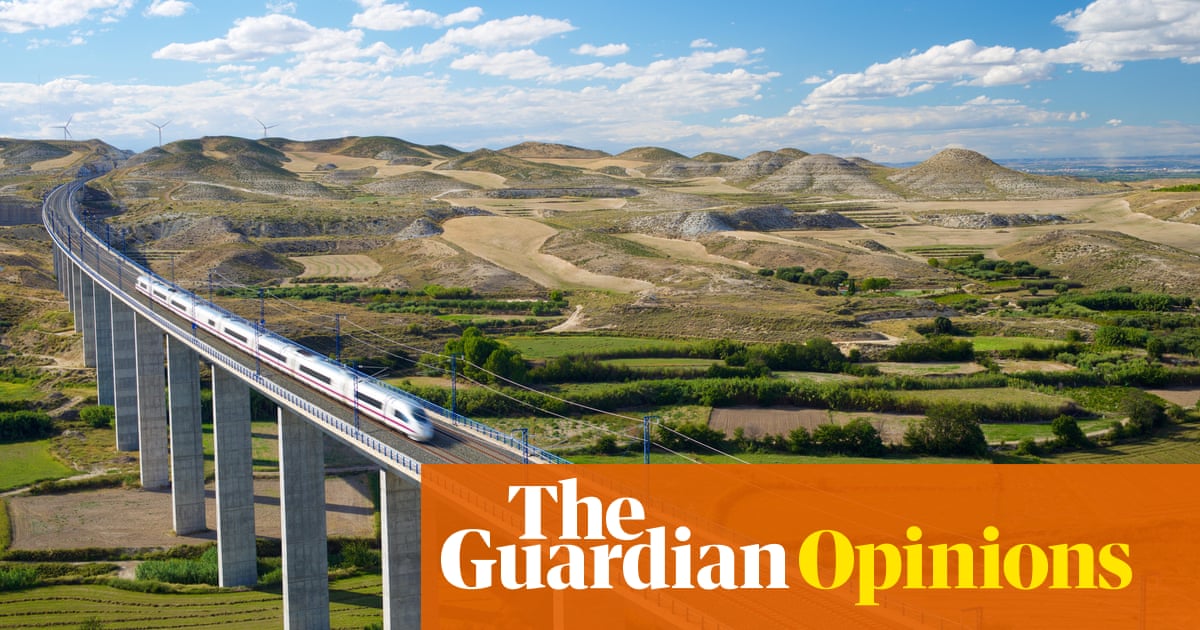
When I was a child, in the 1980s, it was almost inconceivable to take the train to travel between most cities in Spain. The default was a car or a bus. And well into the 1990s a rail journey involved an old, decrepit and congested train. Now it’s almost inconceivable not to take the train if you want to get from Madrid to Barcelona, Seville or Valencia.
The country has managed to build itself the longest high-speed rail network in Europe and the second longest in the world, now spanning approximately 2,500 miles (4,000km) (and still expanding). By way of comparison, France has built 1,740 miles (2,800km), and Britain – still coming to terms with its latest high-speed fiasco – 68 (110km).
It is worth reflecting on Spain’s experience and whether there are lessons for other countries. By any standard, the extent of the network in Spain is an achievement that can be traced directly to a combination of unusual political consensus and EU funding. But it is a transformation that has also changed people’s lives – trains are increasingly the fastest and cheapest way to travel around the country. More than 300 high-speed trains operate daily. They are almost always on time. (If a Renfe high-speed train is delayed by more than 15 minutes, you get a 50% refund of the cost of your ticket. If the delay exceeds 30 minutes, you get a full refund.)
I am writing this piece, for example, on board a high-speed train from Madrid to Barcelona. The journey takes two and a half hours and covers almost 400 miles (620km), approaching the distance between London and Edinburgh. I paid €19, significantly less than the cost of a taxi ride from Madrid city centre to the airport, or the train fare for the four-and-a-half-hour rail journey between London and Edinburgh.
Not every route is this cheap and well-served, although intense competition, a feature since the market was liberalised, usually means passengers can find bargain fares and a range of travel options on the Madrid to Barcelona route as well as for travel to cities such as Valencia and Seville. The network also reflects persistent inequalities around the country, but you can reach most major cities in Spain in three hours or less from Madrid by high-speed rail.
The trains are consistently packed – breaking passenger-number records over the past two years – and major projects are under way to enhance stations and build capacity for more trains. This is what is now expected from rail transport in Spain. So hearing about HS2 being partially cancelled in the UK was very surprising for Spaniards – and the British government’s arguments against the extension were even harder to understand.
High-speed trains have transformed the fortunes of cities across Spain since the opening in 1992 of the first line, between Madrid and Seville, which that year hosted Expo 92. People living in medium-sized urban centres, in particular, have witnessed increased tourism and an influx of commuters and remote workers. Some towns are now even described as “AVE cities”, a reference to the name of the publicly owned high-speed service (ave meaning “bird” in Spanish).
Take León, a northern city of 120,000 people, with an ageing population, a declining post-industrial economy and a renowned Gothic cathedral. Since the arrival of the high-speed train in 2015, it takes less than two hours to get between Madrid and León and tourism is booming. While fares are not as low as on other routes, it’s easy to take even a daytrip from the Spanish capital. Twenty years ago, the same journey took nearly five hours.
Spain suffered as much from the economic effects of the pandemic as the UK did and remote working has become common. But changing routines have brought more passengers on to the trains, not fewer, as the British government suggested as a reason for blocking further high-speed train construction.
So how did Spain get it right? European Union funding was certainly a gamechanger. It was available to other countries too, but Spain was particularly effective in using it for infrastructure. The country has spent around €57.2bn in building its network, with one in four euros coming from EU funding. It still required a strong public commitment of both funds for construction and to subsidise low prices. Private companies didn’t enter the picture until the service was reliable and extensive. The railway network is still in public hands.
Construction costs were lower than in Britain, partly because of lower population density. You don’t have to displace communities in the almost empty plains that many trains run through. Nevertheless the mountainous terrain means some routes have proved to be costly and have also experienced significant delays.
The route to Asturias in northern Spain, is an example. The final leg, from León, will start operating this November – 20 years after planning began. This leg has ended up costing €4bn for just 30 miles (50km) of track, five times the average cost for high-speed rail in Spain. The project also created flooding and water shortages, and the excessive costs came in for both public criticism and legal scrutiny. But no government gave up on it. Now Asturias is expecting to double the number of people using its train services and increase transport of goods by rail too.
Other challenges have included terrorism and sabotage in the Basque Country and Catalonia. But the broad political consensus in favour of developing more train lines prevailed. Conservatives and socialists have been equally enthusiastic, and prime ministers from across the political spectrum have been eager to inaugurate the new routes, often using them as campaign promises. As in other countries, the political right opposes low-emissions traffic and pedestrian zones and would prefer to prioritise cars in Madrid and other cities – but no politician would dare to question high-speed trains, such is their popularity. The debates that do arise tend to focus on why a particular city lacks a train connection that is as good or as cheap as its neighbour’s.
Spain’s powerful regional governments have also been key to the growth of the network. As Pedro Sánchez seeks parliamentary support to form a new government, a recurring demand from the Basque regional party is to accelerate works for the link between Bilbao and San Sebastián, two of the few major cities still not connected by high-speed rail.
High-speed rail isn’t going to solve every transport challenge. Local train networks in Spain remain slow and frequently plagued with problems, particularly in Catalonia. Some regions, often the poorest and most isolated, are underserved even by regular trains. The western region of Extremadura, bordering Portugal, has long suffered from outdated, inadequate services. And the expanding dormitory cities on the outskirts of Madrid or Barcelona are often poorly connected by any public transport.
Still, overall, Spain’s railways ranked eighth in the world in a 2019 World Economic Forum Index. In Europe, only Switzerland, the Netherlands and Finland earned better scores. It’s part of our self-deprecating culture to complain a lot and think that “Europe” always performs better than us, so many Spaniards don’t realise that our high-speed network is the most extensive in Europe or that the UK comes nowhere close to emulating Spain’s success. But they also would simply find it difficult to imagine living without high-speed trains.
María Ramírez is a journalist and deputy managing editor of elDiario.es, a news outlet in Spain












